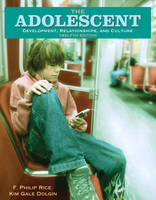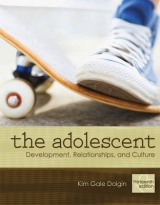
The Adolescent
Pearson (Verlag)
978-0-205-53074-8 (ISBN)
- Titel erscheint in neuer Auflage
- Artikel merken
Contents
Features xi
Preface xiii
Part One Adolescence
Chapter 1 Adolescents in Social Context 1
Approaches to Studying Adolescence 3
The Changing Face of American Adolescence 4
Our Society in Revolution 4
The Prolongation of Adolescence 7
The Revolution in Information Technology 7
The Internet 7
Potential Hazards of Internet Use 8
The Revolution in the Workplace 9
Multiple Jobholders and Overtime Work 9
Working Women 10
Adolescent Employment 10
Advertising and Consumption 11
The Education Revolution 11
Educational Attainment 11
Embracing the New Technology 11
Innovations in Career Education 12
The Family Revolution 12
Changes in Marriage and Parenthood 12
Changes in Family Dynamics 14
The Sexual Revolution 16
Positive Effects of the Sexual Revolution 16
Negative Effects of the Sexual Revolution 16
The Violence Revolution 17
Violent Crime 18
Violence in Society 18
Violence in the Home 19
Violent Deaths 19
A Caveat to Understanding Adolescence 19
Chapter 2 Adolescents in Theoretical Context 24
Biological Views of Adolescence 26
G. Stanley Hall: Sturm und Drang 26
Arnold Gesell: Spiral Growth Patterns 27
Psychoanalytical and Psychosocial Views
of Adolescence 27
Sigmund Freud: Individuation 27
Anna Freud: Defense Mechanisms 29
Erik Erikson: Ego Identity 30
Cognitive Views of Adolescence 32
Jean Piaget: Adaptation and Equilibrium 32
Robert Selman: Social Cognition 34
Lev Vygotsky: Social Influences on Cognition 36
Social-Cognitive Learning View of Adolescence 37
Albert Bandura: Social Learning Theory 37
Social-Cognitive Theory 38
The Impact of Culture on Adolescents 38
Robert Havighurst: Developmental Tasks 38
Kurt Lewin: Field Theory 40
Urie Bronfenbrenner: An Ecological Model 41
Margaret Mead and Ruth Benedict: Anthropological Views 42
Chapter 3 Adolescent Diversity: Socioeconomic Status and Ethnicity 48
Adolescents of Low Socioeconomic Status 50
Limitations of Low Socioeconomic Status 51
Cycle of Poverty and Deprivation 51
Minority Adolescents 55
African American Adolescents 56
Latino Adolescents 60
Native American Adolescents 64
Asian-American Adolescents 67
Immigrants and Refugees 68
Southeast Asian Refugee Experience 69
PART TWO PHYSICAL
Chapter 4 Body Issues: Sexual Maturation and Physical Growth 74
Biochemical Basis of Puberty 76
The Hypothalamus 76
The Pituitary Gland 76
The Gonads 77
The Adrenal Glands 78
Sex Hormone Regulation in Males 78
Sex Hormone Regulation in Females 78
Maturation and Functions of Male Sex Organs 79
Spermatogenesis 80
The Developing Penis 80
The Cowper’s Glands 81
Nocturnal Emissions 82
Maturation and Functions of Female Sex Organs 82
The Developing Vagina 82
Changes in the Vulva and Uterus 82
Ovarian Changes 82
Menarche and the Menstrual Cycle 82
Menstrual Concerns 86
Development of Secondary Sexual Characteristics 87
Males 88
Females 88
Results of Sexual Maturation 90
Growth in Height and Weight 90
Growth Trends 91
Determinants of Height 91
Other Physical Changes 91
Chapter 5 Body Issues: Health-Related Behaviors and Attitudes 94
Health Status 96
Mortality 96
Health Decisions 96
Adolescent Health in the Third World 98
Body Image 98
Physical Attractiveness 98
Body Types and Ideals 99
Early and Late Maturation 101
Early-Maturing Boys 101
Late-Maturing Boys 101
Early-Maturing Girls 103
Late-Maturing Girls 103
Off-Time Maturation 103
Weight 104
Personal Contributors to Being Overweight 104
Interpersonal Interactions and Being Overweight 105
Environmental Influences 106
Broader Social Influences 106
Eating Disorders 106
Anorexia Nervosa 106
Bulimia 108
Health-Related Behaviors 109
Nutrition 109
Exercise 111
Sleep 112
Acne 112
Skin Gland Development 113
Causes 113
Treatment 113
PART THREE INTELLECTUAL
Chapter 6 Traditional Approaches to Cognitive Development: Piaget and Elkind 116
Piaget’s Stages of Cognitive Development 118
Sensorimotor Stage 118
Preoperational Stage 119
Concrete Operational Stage 120
Formal Operational Stage 122
Effects of Adolescent Thought on Personality
and Behavior 125
Idealism 125
Long-Term Values 126
Hypocrisy 126
Pseudostupidity 127
Egocentrism 127
Introspection 129
Self-Concept 129
Critique of Piaget’s Theory 129
Criticisms of Piaget’s First Two Stages 129
Age and Development 129
Consistency 130
Beyond Formal Operations 130
Culture and Environment 130
Motivation and Response 131
What Can We Retain from Formal Operations? 132
Chapter 7 New Approaches to Cognitive Development: Information Processing, Decision Making, and Assessment Issues 136
Information Processing 138
Steps in Information Processing 138
Processing Speed 141
Higher-Order Thought Processes 141
Problem Solving 143
The Role of Knowledge 143
Decision Making 143
The Process 143
The Nine Cs of Decision Making 144
Epistemological Understanding 146
Brain Development during Adolescence 147
Assessing Cognition 148
Theories of Intelligence 149
Intelligence Tests 151
Changes with Age 151
Factors Influencing Test Results 151
Uses and Misuses of IQ Tests 153
Achievement Tests 154
The Scholastic Assessment Test (SAT) 154
PART FOUR PSYCHOSOCIAL
Chapter 8 Self-Concept, Identity, Ethnicity, and Gender 158
Self-Concept and Self-Esteem 160
Importance of Having a Good Self-Concept 161
Self-Esteem 162
Mental Health 163
Interpersonal Competence and Popularity 163
Progress in School 163
Vocational Aspirations 164
Delinquency 164
Development of a Positive Self-Concept 165
Changes in Self-Concept during Adolescence 168
Identity 168
Seven Conflicts 169
Identity Status 170
Identity as a Process 174
Ethnic Identity 175
Gender 178
Biological Sex 178
Cognitive-Developmental Theories 179
Societal Influences 179
Androgyny 182
Gender in Adolescence 182
Chapter 9 Sexual Values and Behavior 186
Changing Attitudes and Behavior 188
Premarital Sexual Behavior 188
Correlates 190
Other Mutual Sexual Behaviors 192
Masturbation 193
Sex and Its Meaning 193
What Are Adolescents Seeking? 193
Sexual Pluralism 193
Gender Differences in Sexual Ethics 195
Sexual Aggression 196
Contraceptives and Sexually Transmitted Diseases 197
Use of Contraceptives among Adolescents 197
Why Contraceptives Are Not Used 200
Should Adolescents Have Contraceptives? 200
Sexually Transmitted Diseases 201
AIDS 202
Unwed Pregnancy and Abortion 205
Incidence of Teen Pregnancy 205
Causation Theories 206
Pregnancy-Resolution Decisions 207
Adolescent Mothers 208
Adolescent Fathers 209
Homosexuality 210
Causation Theories 211
Identity Adjustment 213
Sex Knowledge and Sex Education 214
Sources of Sex Information 215
The Role of Parents 215
The Role of Schools 216
PART FIVE FAMILIAL
Chapter 10 Adolescents and their Families 222
Parenting Adolescents 224
What Kinds of Parents Do Adolescents Want? 224
Connection 224
Trust 228
Attachment Style 228
Autonomy 228
Regulation 230
Parent-Adolescent Tension 234
Differences in Outlook 234
Focus of Conflict 235
Variables Affecting Conflict 236
Conflicts with Parents versus Conflicts with Peers 237
Results of Conflict 237
Relationships with Other Family Members 238
Adolescent-Sibling Relationships 238
Relationships with Other Relatives 239
Maltreatment 240
Physical Abuse 240
Sexual Abuse 240
Incest 241
Neglect 241
Chapter 11 Divorced, Parent-Absent, and Blended Families 244
With Whom Do American Adolescents Live? 246
Divorce and Adolescents 247
Attitudes toward Divorce 247
Short-Term Emotional Reactions 247
Long-Term Effects 249
Factors Influencing the Effects of Divorce 251
Single-Parent/Grandparent-Headed Families 255
Single-Parent Families Resulting from Parental Death 257
Effects of Being Raised in a One-Parent Family 258
Development of Masculinity/Femininity 258
Influences on School Performance, Achievement, and Vocation 259
Blended Families 259
Adopted Adolescents 263
PART SIX SOCIAL
Chapter 12 Social Development: The Changing Nature of Friendship and Romance 266
Companionship 268
The Need for Friends 268
Loneliness 269
Family and Peer Relationships 270
Early Adolescent Friendships 270
Broadening Early Friendships 272
Friendship Activities 272
Group Acceptance and Popularity 273
What Does It Take to Be Popular? 273
Routes to Social Acceptance 274
The Darker Side of Peer Interactions: Bullying 276
Heterosociality 278
Psychosocial Development 278
Adolescent Love and Crushes 280
Loss of Love 280
Dating 281
The Development of Dating 282
Violence 283
“Going Together” 284
Nonmarital Cohabitation 285
Incidence 285
Meanings Attached to Cohabitation 285
Cohabitation versus Dating 287
Adjustments to Cohabitation 287
Effects on Subsequent Marriage 288
Cohabitation and Premarital Childbearing 288
Adolescent Marriage 289
Trends and Incidence 289
Prospects and Prognosis 290
A Profile of the Young Married 290
Reasons for Adolescent Marriage 290
Adjustments and Problems 291
Early Marriage and Education 293
Chapter 13 Adolescent Society, Culture, and Subculture 296
Culture and Society 298
The Adolescent Subculture 298
A False Dichotomy 298
Distinctive Social Relationships and Culture 299
Adolescent Societies 299
Formal Societies 299
Informal Societies 300
Division by Grade 300
Social Class and Status 300
Formal and Semiformal Subsystems 300
The Formal Academic Subsystem 300
The Semiformal Activities Subsystem 301
The Friendship Subsystem 302
Notable Youth Subcultures 303
Flappers 303
Hippies 304
Skateboarders 304
Hip-Hop 305
Goths 305
Material Concerns of Adolescent Culture 306
Adolescents as Consumer Forces 306
Clothing 307
Automobiles 309
Cell Phones 310
Computers and the Internet 311
Nonmaterial Concerns of Adolescent Culture 313
Slang 313
Music 313
Chapter 14 The Development of Moral Values 320
Cognitive-Socialization Theories of Development 322
Kohlberg and Levels of Moral Development 324
Gilligan and Sex Differences in Moral Reasoning 328
The Social-Cognitive Domain Approach to Moral Reasoning 329
Moral Reasoning and Prosocial Behavior 330
Family Factors and Moral Learning 332
The Family’s Role 332
Extrafamilial Influences on Morality 334
Peers 334
Religion 334
Television 336
Moral Education 339
Part Seven Educational and Vocational
Chapter 15 Education and School 344
Trends in U.S. Education 346
Traditionalists versus Progressives 346
Rise of Progressive Education 346
Sputnik and After 346
1960s and 1970s 346
1980s 347
1990s 348
Early Twenty-First Century 349
Middle Schools 349
Characteristics of Good Schools 351
Size 352
Atmosphere 352
Teachers 353
Curriculum 354
Private versus Public Schools 355
Achievement and Dropping Out 356
Enrollment Figures 356
Who Drops Out and Why 356
Dropouts and Employment 362
Chapter 16 Work and Vocation 366
Motives for Choice 368
Theories of Vocational Choice 368
Ginzberg’s Compromise with Reality Theory 368
Holland’s Occupational Environment Theory 371
Gati’s Sequential Elimination Model 372
People Influencing Vocational Choice 372
Parents 372
Peers 374
School Personnel 374
Gender Roles and Vocational Choice 374
Other Crucial Determinants of Vocational Choice 377
Intelligence 377
Aptitudes and Special Abilities 378
Interests 378
Job Opportunities 379
Salary 380
Prestige 380
Socioeconomic Factors 380
Familiarity 380
Social Status and Aspirations 380
Race/Ethnicity and Aspirations 381
Youth Employment 381
Working for Wages 381
Volunteerism 385
Adolescents and Unemployment 386
Numbers of Unemployed Youths 386
Causes of Unemployment 386
Career Education 387
PART EIGHT PSYCHOSOCIAL PROBLEMS
Chapter 17 Adolescent Alienation 392
Running Away 394
Classes of Runaways 394
Reasons for Running Away 394
Throwaways 396
Life on the Street 396
Help for Runaways 396
Worldwide Scope 397
Suicide 397
Frequency of Suicide 397
Causes and Motives of Suicide 399
Copycat Suicides 403
Unsuccessful Attempts 403
Survivors 404
Juvenile Delinquency 404
Incidence of Delinquency 404
Causes of Delinquency 406
Juvenile Gangs 409
The Juvenile Justice System 411
The Restorative Justice Movement 414
Prevention of Juvenile Delinquency 414
Chapter 18 Substance Abuse, Addiction, and Dependency 418
Drug Use and Abuse 420
Physical Addiction and Psychological Dependency 420
Patterns and Intensity of Drug Use 420
Types of Drugs 421
Frequency of Adolescent Drug Use 427
Reasons for First Drug Use 429
Demographic Differences 430
Compulsive Drug Use 430
Prevention and Treatment 431
Tobacco and Smoking 435
Incidence of Tobacco Use 435
Reasons Adolescents Start Smoking 435
Effects of Cigarette Advertising 436
Reasons Adolescents Continue Smoking 437
Smokeless Tobacco 437
Keeping Adolescents from Starting 438
Alcohol and Excessive Drinking 439
Incidence of Alcohol Abuse 439
Reasons for Drinking during Adolescence 440
Adult and Peer Influences 441
Physical Consequences of Alcohol Use 442
Drinking in Young Adulthood 442
Epilogue 446
Glossary 448
Bibliography 453
Index 506
| Erscheint lt. Verlag | 22.6.2007 |
|---|---|
| Sprache | englisch |
| Maße | 216 x 276 mm |
| Gewicht | 1070 g |
| Themenwelt | Sozialwissenschaften ► Soziologie |
| ISBN-10 | 0-205-53074-5 / 0205530745 |
| ISBN-13 | 978-0-205-53074-8 / 9780205530748 |
| Zustand | Neuware |
| Haben Sie eine Frage zum Produkt? |
aus dem Bereich



